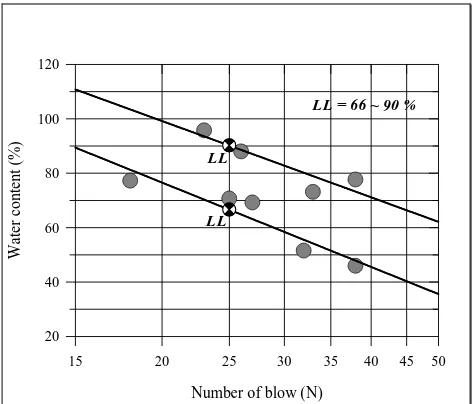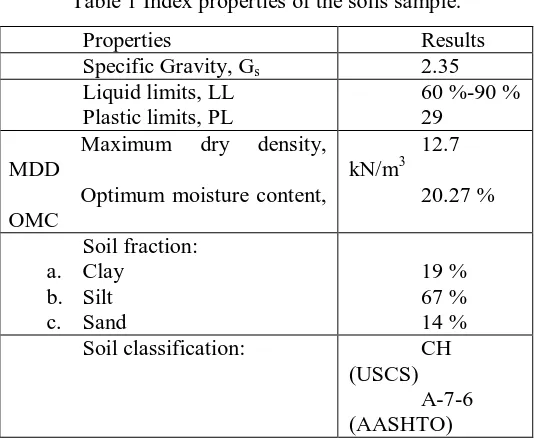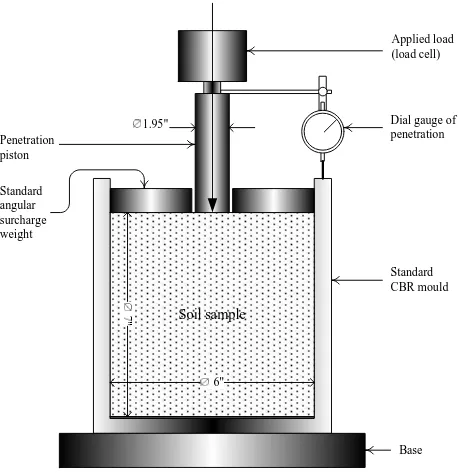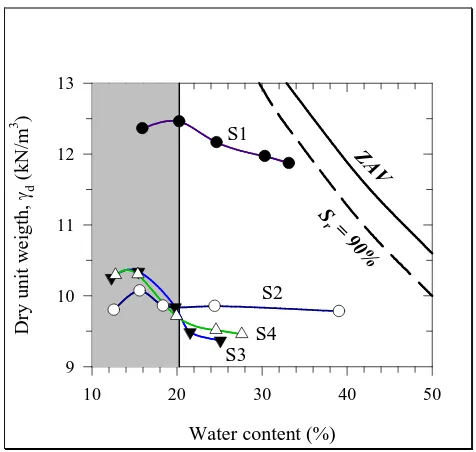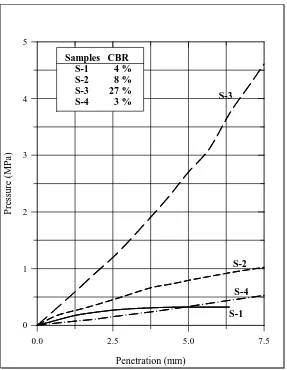USES OF LIME -RICE HUSK ASH AND PLASTIC FIBERS
AS MIXTURES-MATERIAL IN HIGH-PLASTICITY
CLAYEY SUBGRADE: A PRELIMINARY STUDY
Ario Muhammad* and Agus Setyo Muntohar, S.T., M.Eng.Sc., Ph.D.** *
Student, Department of Civil Engineering, Universitas Muhammadiyah Yogyakarta **
Senior Lecturer, Department of Civil Engineering, Universitas Muhammadiyah Yogyakarta
ABSTRACT
Silica produced from rice husk ashes have investigated successfully as a pozzolanic material in soil stabilization. However, rice husk ash cannot be used solely since the materials lack in calcium element. As a result, rice husk ash shall be mixed with other cementitious materials such as lime and cement to have a solid chemical reaction in stabilization process. The main objective of this study focused on bearing capacity of the stabilized clayey subgrade with lime-rice husk ash and fibers. The main laboratory test shall be compaction and CBR tests. The investigation results revealed that the inclusion of lime-rice husk ash-fiber into the soil decreased MDD and OMC. On the other hand, stabilization and reinforcement with lime-rice husk ash and fibers waste improved significantly the CBR values. Keywords: soil improvement, clay soil, lime-rice husk ash, plastic-sack fiber,
compaction, CBR.
INTRODUCTION
Review Of The Rice Husk Ash Stabilized Soils
Basha et al (2004) reported that rice husk ash was potentially to stabilize the expansive and non expansive soils solely or by mixing with cement. In general, 6 – 8 % of cement and 10 – 15 % rice husk ash showed optimum amount to improve the properties of soils. Reduction in plasticity index, the increase of strength and resistance to immersion were indicator of soil improvement. Addition of lime and rice husk ash reduced liquid limits while the plastics limits increase. As a result, the plasticity indices reduced. Reducing the plasticity index resulted in increases of the shear strength, cohesion, and internal friction angle of the stabilized soils (Muntohar, 2002).
To improve tensile strength of the stabilized soils, Muntohar (2006) reinforced the stabilized soil by using plastic-sack fibers. The investigation showed that plastic-sack fiber increased the tensile strength of the stabilized soil with lime and rice husk ash. Santoni et al. (2000) observed that inclusion of the fiber in sand soils improved the unconfined compressive strength.
RESEARCH METHOD
Materials used
Soil
Figure 1 Particle size distribution of the soil used in this study.
Number of blow (N)
15 20 25 30 35 40 45 50
W
at
er
c
o
n
te
n
t
(%
)
20 40 60 80 100 120
LL LL
LL = 66 ~ 90 %
Table 1 Index properties of the soils sample.
Properties Results
Specific Gravity, Gs 2.35 Liquid limits, LL
Lime and Rice Husk Ash
The lime used in this study was powder-hydrated lime. For soil stabilization purpose, materials passed ASTM sieve No. 40 (0.43 mm) was used as mixture material. The rice husk ash was produced locally which has obtained from rice husks burnt in a brick industry near Yogyakarta. To produce a fine rice husk ash, the rice husk should pass the ASTM sieve size No. 40. Both of the lime and rice husk ash are stored in air-tight plastic bag to prevent hydration reaction with environment-moist.
Fibers
The fibers used in this research were obtained from plastic-sack waste which is predominantly made from polypropylene materials. The fibers was decomposed and seized in 5 mm to 25 mm length. The fibers width was about 1.5 mm.
Laboratory Tests
samples were kept cured in air-tight plastic bags to prevent the loss of moisture for 14 days and to allow chemical reaction between the soil and admixtures.
The basic CBR test involves applying load to a small penetration piston at a rate of 1.3 mm (0.05") per minute and recording the total load at penetrations ranging from 0.64 mm (0.025 in.) up to 7.62 mm (0.300 in.). Figure 3 shows the sketch of CBR test. Values obtained are inserted into the following equation to obtain a CBR value:
100%
as
P
CBR
P
where:
Pa =
unit load on the piston (pressure) for 2.54 mm (0.1 in.) or 5.08
mm (0.2 in.) of penetration
Ps =
standard unit load (pressure) for well graded crushed stone:
P
s= 6.9 MPa (1000 psi) for 2.54 mm (0.1") penetration
P
s= 10.3 MPa (1500 psi) for 5.08 mm (0.2") penetration
Soil sample
Applied load (load cell)
Dial gauge of penetration
Standard CBR mould
Base Penetration
piston
1.95"
6" Standard
ANALYSIS AND DISCUSSION
The tests results of proctor-standard compaction and CBR are presented in the Table 2. The following section will present the discussion of the test results.
Table 2 Geotechnical Properties of Treated Samples.
o. OMC = optimum moisture content.
Compaction Characteristics
Water content (%)
Figure 4 Compaction characteristics of the soil samples (ZAV = zero air void, Sr = degree of saturation).
Theoretically, increasing of maximum dry density value is an indicator of improvement. But, this characteristic is shown in the recent study. The possible reasons causing the behavior is owing to the flocculated soil-grain as a result of the pozzolanic reaction between lime-rice husk ash and soils. Coincidently, a larger void was formed between the soil particles and then, the void was occupied by air. However, since the pozzolanic reaction yield stiffer granulated-soil skeleton, the stabilized soil was not easier to be compacted at the same compactive energy as the unstabilized soil. As shown in Figure 4, the dry density of stabilized soils is located below the zero air void curve. Muntohar (2002) indicated that decreases in maximum dry density of stabilized clay soil with line-rice husk ash were owing to low specific gravity.
California Bearing Ratio (CBR)
penetration. Figure 5 shows the CBR test results of the soil samples which present pressures at various penetrations.
Penetration (mm)
0.0 2.5 5.0 7.5
P
re
ss
u
re
(
M
P
a
)
0 1 2 3 4 5
S-3
S-2
S-4
S-1 Samples CBR
S-1 4 % S-2 8 % S-3 27 % S-4 3 %
Figure 5 Pressure and penetration relationship of the tested soil samples.
decreasing of the CBR value to about 3%. However, the penetration curve of the stabilized soils (S4) can be extended up to 7.5 mm.
Table 3 Classification of the CBR values for subgrade or base course layer. (Bowles, 1986) the given CBR values, the rating of the subgrade range from fair to excellent.
CONCLUSIONS
This study has been successfully investigated the used of lime-rice husk ash and fiber waste as stabilization and reinforcement for clay soils. Based on the investigation results, the following conclusions can be drawn:
1. Addition of the lime and rice husk ash in clay soil decreases significantly the maximum dry density and optimum moisture content. Inclusion of the fibers waste only reduces slightly the maximum dry density and optimum water content of the stabilized soils.
REFERENCES
ASTM. 2003. Standard Test Methods for Laboratory Compaction Charactheristics of Soil Using Standard Effort, D 698-70, pp. 78-87.
ASTM. 2003. Standard Test Methods for CBR of Laboratory-Compacted Soils, D 1883-73, pp. 171-177.
Basha, E.A., Hashim, R., Muntohar, A.S., 2004, Stabilization of clay and residual soils using cement-rice ash mixtures, Jurnal Teknik Sipil Vol. 5, pp. 51 – 66. Bowles, E.J., 1986, Engineering Properties of Soils and Their Measurement, Mc
Graw-Hill, Singapore.
Muntohar, A.S., 2006, Kuat Dukung tanah Lempung Dengan Campuran LRHA dan Serat Karung Plastik, Laporan Penelitian Dosen Muda (Research Sponsored by Directorate General of Higher Education), Fakultas Teknik, Universitas Muhammadiyah Yogyakarta.
Muntohar, A.S., 2002, Utilization of uncontrolled burnt rice husk ash in soil improvement, Dimensi Teknik Sipil, Vol. 4, pp. 100 – 105.
